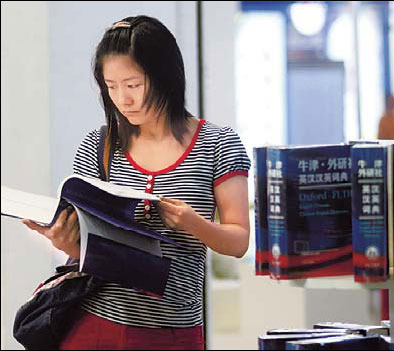The 115-year-old prestigious Oxford Dictionary will now include popular new Chinese terms like "shanzhai" "youtiao" and "fangnu", as part of the modern Chinese language.
|

A woman reads the new Oxford English-Chinese, Chinese-English dictionary at the Beijing International Book Fair last week. For the first time, the dictionary now includes some fashionable Chinese words like "shanzhai", "youtiao" and "fangnu", which are popular among netizens.
|
As China plays a more and more important role in the world economy, the Chinese language is forever evolving, attracting more attention from people who want to understand this ancient yet vibrant language.
For instance, the word "shanzhai" is used to describe the plethora of cheesy wigs on sale in many shops and markets. Or another example would be the countless knockoffs of iPhones or designer bags imprinted with Louis Vuitton logos.
Another new term in the new edition is the word "fangnu", or a "mortgage slave" - a term used to describe the phenomenon in larger cities whereby well-educated youth complain of a miserable existence due to the heavy burden of a home mortgage.
All these new or often fashionable terms can be found in the new Oxford Chinese-English, English-Chinese dictionary that was unveiled in the recently concluded Beijing International Book Fair last week.
The dictionary now is available for retail sales since the beginning of this month.
This dictionary is the largest single volume English-Chinese, Chinese-English dictionary and contains 670,000 words and phrases after five years of preparation. Sixty editors from the Oxford University Press and its partner in China - the Foreign Language Teaching and Research Press - worked together on the project. According to Julie Kleeman, the dictionary's chief editor, most of the firm's editors were Chinese, while about one fourth were native-English speakers.
"We don't want to make it florid, we want it to be modern and conversational many of the words in the present dictionary are no longer in use," said Kleeman. "The need for studying Chinese by foreigners today is totally different from decades ago Precise, native and practical - that is our core advantage," she said.
She added the dictionary also has a sidebar section that explains words that pack in too much cultural information, like "hutong", a traditional architecture style common in the narrow lanes of Beijing. Another would be "youtiao" the popular Chinese breakfast staple usually eaten with soybean milk.
According to the Foreign Language Teaching and Research Press' press release, terms included in the new version of dictionary were selected from both the Oxford English Corpus and the, City University of Hong's LIVAC Synchronous Corpus.
Kleeman said newer publications updates will be available only for the online version as language often changes too quickly for book versions to keep pace. The online version will also offer a Chinese phonetic pronunciation guide.
The online version, allowing access via different platforms from the PC to the iPad, will be ready "as soon as possible", Kleeman said.
(China Daily September 6, 2010)
Go to Forum >>0 Comments